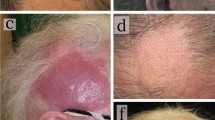Abstract
After determining the usual malassezic biota of the scalp in adult, normal persons, 259 patients with different desquamative diseases were studied by a simple adhesive tape technique. The main purpose of this study was to investigate the utility of this technique to improve the diagnosis and treatment of patients. Most patients with seborrhoeic dermatitis and sebopsoriasis demonstrated large numbers of {it Malassezia} spp. cells corresponding to the so called ``pityrosporosis''. Only 43.6% of patients with pityriasis capitis (dandruff) presented with such a diagnosis. Symptomatic pityrosporosis of the scalp should be treated with imidazolic derivatives or other antifungal substances. Patients with psoriasis of the scalp showed a typical microscopic picture represented by parakeratosic (nucleated) keratinocytes with absence of lipophilic yeasts which should be attributed to the usual dryness of the scales .Microbial epidermitis (eczema) of the scalp revealed another characteristic picture constituted by abundant leukocytes and bacteria without the presence of yeasts. The different microscopic pictures seen with this simple technique for diseases of the scalp, offer an adjunct to make a proper diagnosis and to establish a convenient treatment in cases which are not clinically well defined.
Similar content being viewed by others
References
Sampaio SAP, Rivitti EA. Dermatologia. Sao Paulo: Artes Medicas, 1998.
Nakabayashi A, Sei Y, Guillot J. Identification of Malassezia species isolated from patients with seborrhoeic dermatitis, atopic dermatitis, pityriasis versicolor and normal subjects. Medical Mycology 2000; 38(5): 337–341.
Hammer KA, Riley TV. Precipitate production by some Malassezia species on Dixon agar. Medical Mycology 2000; 38(2): 105–107.
Borelli D. Pitiriasis versicolor. Dermatologia Venezolana 1987; 25(3–4): 13–18.
Malassez L. Note sur le champignon du pityriasis simple. Arch Physiol 1874; 1: 451.
Castellani A, Chalmers AJ. Manual of Tropical Medicine. 2nd edition. London: Bailliere, Tindall and Cox, 1913.
Gordon M. A lipophilic yeastlike organisms associated with tinea versicolor. J Invest Dermatol 1951; 17: 267.
Civila FS, Vignale R, Sanjines A, Conti Diaz IA. Hyphal production by Pityrosporum ovale. Int J Dermatol 1978; 17: 74–77.
Civila ES, Vignale R, Conti Diaz IA. Malassezia ovalis: Mycologic and immunoantigenic aspects and probable pathogenic role. In: Superficial cutaneous and subcutaneous infections. PAHO Scient Publ 396. Caracas, Venezuela, 1980: 55–62
Sabouraud R. Maladies du cuir chevelu: II. Les maladies desquamatives. Paris: Masson et Cie 1904, 646.
Moore M. Dermatitis seborreica El cultivo del organismo causal y la produccion experimental de la dermatitis. Arch Urug Med 1936; 8: 245.
Leyden JJ, McGinley Kligman AM. Role of microorganisms in dandruff. Arch Dermatol 1976; 112: 333.
Midgley G, Hay RJ. Serological responses to Pityrosporum (Malassezia) in seborrhoeic dermatitis demonstrated by ELISA and Western Blotting. Bull Soc Fr Mycol Med 1988; 17: 267–276.
Faergemann J. Pityrosporum yeasts what s new. Mycoses 1997; 40(1): 29–32.
Dobrev H, Zissova L. Effect of ketoconazole 2% shampoo on scalp sebum level in patients with seborrhoeic dermatitis. Acta Derm Venereol 1977; 77(2):132–134.
Neuber K, Kroger S, Grusec E et al. Effects of Pityrosporum ovale on proliferation, immunoglobulin (IgA, G, M) synthesis and cytokine (IL-2, IL-10, IFN gamma) production of peripheral blood mononuclear cells from patients with seborrhoeic dermatitis. Arch Dermat Res 1996; 288(9): 532–536.
Kesavan S, Holland T, Ingham F. The effects of lipid extraction on the immunomodulatory activity of Malassezia species in vitro. Medical Mycology 2000; 38(3): 239–247.
Civila E, Vignale R. Ausencia de Pityrosporum (Malassezia) como elemento orientador en el diagnostico de la psoriasis de cuero cabelludo. Resumenes II Congreso Uruguayo de Dermatologia 1988; 14–15.
Baker BS, Powles A, Garioch JJ et al. Differential T cell reactivity to the round and oval forms of Pityrosporum in the skin of patients with psoriasis. Br J Dermatol 1997; 136(3): 319–325.
Heng MCY, Henderson ChL, Barker DC et al. Correlation of Pityrosporum ovale density with clinical severity of seborrheic dermatitis as assesses by a simple technique. J Am Acad Dermatol 1990; 23: 82–86.
Padilha Goncalves A. A simple method to stain Malassezia furfur and Corynebacterium minutissimum in scales. Rev Inst Med trop Sao Paulo 1996; 38(49): 299–302.
McGinley KJ, Leyden JJ, Marples RR et al. Quantitative microbiology of the scalp in non-dandruff, dandruff and seborrhoeic dermatitis. J Invest Dermatol 1975; 64: 401–405.
Author information
Authors and Affiliations
Rights and permissions
About this article
Cite this article
Conti Diaz, I.A., Civila, E. & Veiga, R. The importance of microscopic examination in the management of desquamative diseases of the scalp. Mycopathologia 153, 71–75 (2002). https://doi.org/10.1023/A:1014467229089
Issue Date:
DOI: https://doi.org/10.1023/A:1014467229089




